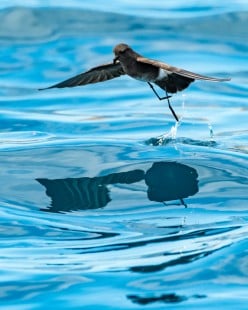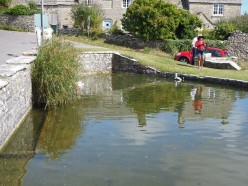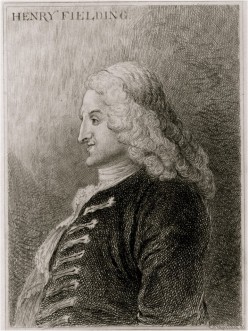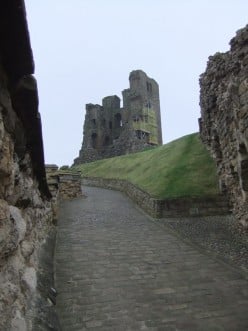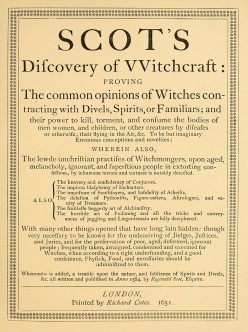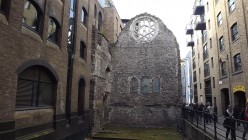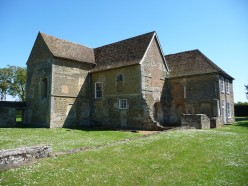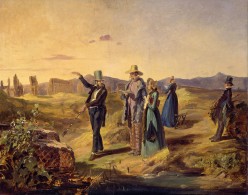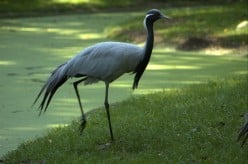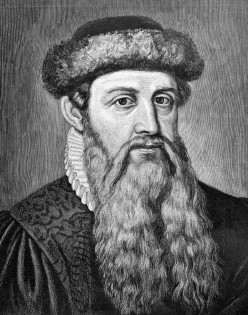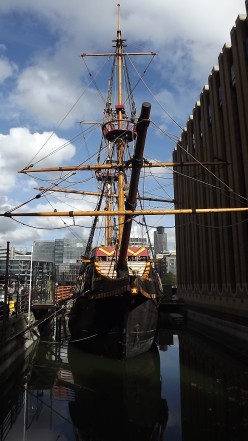 82
82- 1
"Ozymandias" by Percy Bysshe Shelley
"Ozymandias" is one of the best-known works by the Romantic poet Percy Bysshe Shelley (1792-1822). It is an unconventional sonnet with strong socio-political themes.
- 2
"Before You Were Mine": A Poem by Carol Ann Duffy
A presentation and analysis of "Before You Were Mine", a poem by a former poet laureate named Carol Ann Duffy.
- 0
Storm Petrel
The storm petrel is a small seabird that is not often seen except out at sea
- 0
Three Wild Flowers of the Potentilla Family
Here are brief descriptions of three members of the Potentilla family that grow wild in the British Isles
- 0
Some Natural Wonders of the Dorset Coast
On the south coast of England, the county of Dorset has one of the most fascinating coasts of any county, with many features of interest packed into a short distance. Here are some of Dorset’s natural wonders along this stretch of the world-famous Jurassic Coast.
- 1
Manx shearwater
The Manx shearwater is a seabird with some remarkable characteristics
- 1
"You and I": A Poem by Roger McGough
A look at a short poem by Roger McGough, a contemporary poet from Liverpool
- 1
"Whaam!": An Artwork by Roy Lichtenstein
"Whaam!" is one of best known examples of Pop Art. It was created by the American artist Roy Lichtenstein in 1963.
- 0
"The Retreat": A Poem by Henry Vaughan
Analysis and discussion of "The Retreat", a poem by a late "metaphysical" poet Henry Vaughan.
- 0
"To Daffodils": A Poem by Robert Herrick
A presentation and discussion of "To Daffodils" by the 17th-century English poet Robert Herrick
- 2
Roman Corinth
The ancient city of Corinth was Greek by location but Roman in most other respects
- 5
Wylye, Wiltshire, England
Wyle is a small English village with some interesting features and tales to tell.
- 0
"The Lamb": A Poem by William Blake
The Lamb is one of the “Songs of Innocence” by William Blake (1757-1827).
- 6
The Ritten Earth Pillars, Italy
The Ritten Earth Pillars are a remarkable survivor from the last Ice Age.
- 0
Fulmar: A Wide-Ranging Seabird
The fulmar (Fulmarus glacialis) is a seabird that is found, when breeding, on the coasts around most of Great Britain and Ireland.
- 2
Natural Wonders of Southern Scotland
Scotland abounds with natural wonders. Here are brief introductions to some those to be found south of the Highlands.
- 2
Great Northern Diver (Common Loon)
The Great Northern Diver is a bird that is known in North America as the Common Loon.
- 2
An Analysis of the "Nativity" Poem by John Donne
"Nativity" is a poem in sonnet form by the "metaphysical" poet John Donne. This article offers an analysis of the poem's structure and content.
- 4
Worth Matravers, Dorset
A short guide to an interesting Dorset village
- 0
D H Lawrence: Method and Sources
David Herbert Lawrence (almost universally referred to as D H Lawrence) was one of the foremost novelists in English during the early 20th century. He was also a noted poet, short-story writer and critic.
- 2
Henry Fielding: Pioneering Novelist and Reforming Magistrate
Henry Fielding (1707-54) is renowned as a pioneer of the English novel, particularly due to his best-known work “Tom Jones”. He was also a reforming London magistrate.
- 5
Scarborough: A North Yorkshire Seaside Resort
Scarborough in North Yorkshire (35 miles north-east of York) has a good claim to being considered Britain’s first seaside resort, but it has a much older history than that.
- 0
"A Bird-Scene at a Rural Dwelling": a poem by Thomas Hardy
A Bird-Scene at a Rural Dwelling is a late poem by Thomas Hardy (1840-1928) that recalls memories from his youth while living at Higher Bockhampton near Dorchester.
- 2
"The Discoverie of Witchcraft": a Book by Reginald Scot
Reginald Scot wrote a fascinating book, published in 1584, that sought to defuse the myths surrounding witchcraft. This was "The Discoverie of Witchcraft", which also served as a history of conjuring.
- 2
Bitter Vetch: a Wildflower
Bitter vetch is a plant that grows wild in Great Britain, especially the west and north.
- 4
"The Destructors": A Short Story by Graham Greene
Graham Greene (1904-91) was best known for his novels, which included “The Power and The Glory”, “The Honorary Consul” and “Brighton Rock”. However, he also wrote a large number of short stories, of which “The Destructors” is an interesting example.
- 7
Christianity is Not Well-Founded
The more I look at the religion known as Christianity, the more I realise that it is far from secure, in theological/philosophical terms, having been built on very shaky foundations.
- 4
"Your Last Drive": A Poem by Thomas Hardy
Thomas Hardy’s poem “Your Last Drive” was included in his “Poems of 1912-13” which formed part of his “Satires of Circumstance,” published in 1914. The poem is dated December 1912.
- 4
Joseph Wright of Derby: A Painter With a Scientific Turn of Mind
Joseph Wright of Derby was an original painter renowned for his paintings that used science and industry as their subjects. He was also a noted portraitist.
- 3
"The Little Vagabond": A Poem by William Blake
"The Little Vagabond" is one of the “Songs of Experience” that were written and etched by the English poet William Blake between the years 1789 and 1794.
- 9
"The Roman Road": A Poem by Thomas Hardy
“The Roman Road” is a short poem by Thomas Hardy (1840–1928) that was published in his 1909 collection “Time’s Laughingstocks and Other Verses”.
- 3
Caravaggio: An Italian Artist With a Violent Streak
Caravaggio (1571-1610) was one of the most extraordinary characters in the history of art. His fiery temper and wild behaviour led to a sometimes tempestuous life, and this violence was reflected in his paintings. His treatment of light added to their drama.
- 4
St David's Cathedral, Wales
St David’s Cathedral is the largest church in Wales, but its home city is the smallest in Great Britain.
- 0
"The Secret Garden": A Father Brown Short Story by G. K. Chesterton
“The Secret Garden” was the second “Father Brown” story written by G K Chesterton (1874–1936).
- 3
"The Year's Awakening": A Poem by Thomas Hardy
Thomas Hardy’s poem “The Year’s Awakening” was published in his 1914 collection entitled “Satires of Circumstance, Lyrics and Remedies." It is dated from February 1910.
- 3
Albrecht Durer: German Painter
Albrecht Dürer was one of a small group of highly talented German artists who were born in the late 15th century. Dürer was particularly noted for his use of graphic art that allowed his work to become widely distributed throughout Europe in the form of prints.
- 4
The Legendary Abbaye Sainte-Foy in Conques, France
Conques is a small village in southern France that is on the tourist trail thanks to the Abbaye de Ste-Foy at its heart.
- 5
"The Deserted Village": A Poem by Oliver Goldsmith
This is a summary and criticism of a well-known English poem with its central idea describing scenes of rural distress during the 18th century.
- 5
The Fate of the Black Market Express
An Italian rail disaster in 1944 killed more than 500 people although the train in question did not crash and was not derailed. This was the “Black Market Express”, so called because of the vital role it played in getting food and other supplies to war-ravaged Naples.
- 2
"The Blue Cross": A Short Story by G. K. Chesterton
“The Blue Cross” is the story in which Gilbert Keith Chesterton (1874-1936) introduces his Catholic priest/detective Father Brown. The story was first published in September 1910.
- 1
English Heritage Properties in Central London
English Heritage maintains six sites in Central London that might be worth visiting as alternatives to the usual tourist traps.
- 2
The Altiplano of South America
The Altiplano towers over the southern Andes, forming a high plateau between the eastern and western Andean chains. It covers an area of some 65,000 square miles (168,000 sq kms) and has a mean elevation of 12,000 feet (3,650 m).
- 3
English Heritage Properties in Cambridgeshire
There are four properties in the English county of Cambridgeshire that are preserved and managed by English Heritage.
- 0
"The Queer Feet": A Short Story by G. K. Chesterton
“The Queer Feet” is the third story in the first book of Father Brown stories by G. K. Chesterton (1874-1936), entitled "The Innocence of Father Brown” (published in 1911).
- 1
English Heritage Properties in Bedfordshire
The English County of Bedfordshire contains four properties that are maintained by English Heritage and made accessible to visitors.
- 1
The Zagros Mountains, Iran
The Zagros Mountains are a snow-covered range of mountains, mainly in south-west Iran, which is normally hot, dry and barren. The range is 550 miles (900 kms) long and 150 miles (240 kms) wide. The highest point is 12,000 feet (3,600 metres) above sea level.
- 0
The Grand Tour
It is a well-respected maxim that travel broadens the mind. For many British young people this takes the form of a “gap year” before going to university. The equivalent in the late 18th and early 19th century – if you could afford it – was the Grand Tour.
- 2
The Great Trek, 1835-40
South Africa’s Afrikaners (Whites of Dutch origin) regard the Great Trek as the event that marked their identity as a people.
- 6
The Diet of Worms, 1521
This event, which concluded on 18th April 1521, has gone down in history with an unfortunate name that means something completely different from what most English-speaking people would assume. It was in fact a fundamental turning point in the history of Christianity.
- 0
Demoiselle Crane
The demoiselle crane (Grus virgo) is found in a broad sweep of semi-arid and steppe land from eastern Europe into central Asia.
- 1
"A Tradition of 1804": A Short Story By Thomas Hardy
Thomas Hardy is known as the author of a series of lengthy novels, which are not always an easy read. However, he also wrote a considerable number of short stories which modern readers might find more approachable. Here is an account of a particularly brief short story.
- 3
Did King Henry VIII Have a Genetic Abnormality?
King Henry VIII's lack of luck in fathering children and his later erratic behavior may have been the result of an inherited medical condition.
- 1
Summary of "The Invisible Man": A Father Brown Short Story by G. K. Chesterton
“The Invisible Man” was the fifth story written by G. K. Chesterton about his priest/detective character Father Brown. It appeared in his original collection of Father Brown stories, entitled “The Innocence of Father Brown”, in 1911.
- 1
The Classical Landscapes of Claude Lorrain
Claude Lorrain was a 17th century French artist who specialized in large-scale landscapes that incorporated scenes from the Bible or mythology
- 0
The First Three King Henrys
A short account of the lives of England's first three kings named Henry
- 2
UNESCO World Heritage Sites in Northen England
A short introduction to the seven sites in Northern England that are recognized by UNESCO as deserving of World Heritage status.
- 3
A Short History of Leicestershire County Cricket Club
Leicestershire County Cricket Club has had its fair share of triumphs and disasters. Here is a short account of the journey to its sorry present state.
- 0
The Beginning of Printing
Printing was not invented by Johann Gensfleich zum Gutenberg, but his innovations turned the concept into something revolutionary.
- 0
The Union Pacific Big Springs Robbery
On 18 September 1877, there was a daring raid on an express train at Big Springs, Nebraska. The gang got away with a fortune in gold coins, but their criminal careers didn't last.
- 0
The Papin Sisters Case
Sisters Christine and Léa Papin killed their employers, two members of the Lancelin family, in a savage crime that shocked France in 1932.
- 2
C. T. Studd: A Cricketer Who Became a Missionary
C. T. Studd was a successful English cricketer who gave it all up to follow a completely new career as a Christian missionary in China, India, and Africa.
- 2
'Tam O'Shanter': a Poem by Robert Burns
'Tam O'Shanter' is an entertaining long poem by Robert Burns that has been one of his most loved pieces of poetry ever since it was published in 1791.
- 0
Eight Kings Named Edward
England/Great Britain has had eight kings named Edward since the Norman Conquest. Here are brief accounts of all of them.
- 1
Three Men in a Boat, by Jerome K Jerome
Three Men in a Boat (To Say Nothing of the Dog) is a Victorian masterpiece that has stood the test of time and is as readable and enjoyable today as it was when it first appeared in 1889.
- 1
Emigration From England to America in the 17th Century
A summary of the causes of emigration from England across the Atlantic in the 17th century
- 2
King Philip Augustus of France
- 9
The Scandal Of Child Marriages In the United States
Forced marriages of under-age girls are a scandal that affects not just the Third World but the West as well. The problem is particularly bad in the USA.
- 4
The Staplehurst Rail Crash of 1865
The Staplehurst rail crash of 9th June 1865 was notable for two main reasons. One is that it happened because somebody failed to read a railway timetable properly, and the other is that a very well-kn
- 3
What Is Automatic Writing?
Some people have claimed to be able to communicate—in writing—the words of dead people. How much credence can be given to such claims? Read on for everything you need to know about "automatic writing."
- 1
What to Know Before Visiting the Vatican in Rome
Vatican City has to be the most unusual independent state in the world. It's unique, and you won't regret visiting. Here's what you need to know before you go!
- 1
The Nature and Purpose of Stonehenge
Stonehenge is one of the World's most famous ancient sites. But why was it built?
- 2
What Are Human Rights Violations?
Most people would agree that humans rights need to be protected, but are we always clear about what counts as a violation of them?
- 1
The Background to the Universal Declaration of Human Rights
Let's explore the documents that influenced the drafting of the Universal Declaration of Human Rights.
- 0
What Is a Movement in Music?
Here is a short explanation of the term "movement" in classical music.
- 1
William the Silent's Death in 1584: Assassinated by Handgun
William the Silent was the first head of state to be assassinated by means of a handheld firearm. Read on for the full story of this historic killing that changed the world.
- 1
The Coup d'Etat of Claude-Francois Malet
Fake news isn't anything new. A piece of fake news nearly led to a French general deposing Napoleon Bonaparte. Read on for the full story of this coup!
- 3
The Origin of Pasta: The Marco Polo Connection
Pasta is associated by most people with Italy. There is a theory that this was thanks to Marco Polo, introduced on his return from China. Could this be true or is it a myth?
- 3
Jacques Benveniste: Double Ig Nobel Prizewinner
Jacques Benveniste gained the unusual honor of being awarded two Ig Nobel prizes for work that appeared to support the claims of homeopathy.
- 0
Pietro da Cortona: 17th-Century Baroque Artist and Architect
Here is a short account of the life and work of Pietro da Cortona, who was a highly influential artist during the Baroque period of the 17th century. Read on for the full story of his life!
- 5
Bernard Montgomery: An Insufferable Field Marshal
Despite being one of Britain's greatest-ever generals, Monty was a very difficult person to deal with.
- 1
Tobacco: How a False Medicine Came From Europe From America
There are few people today who would deny that the use of tobacco has been an unmitigated disaster in terms of public health and unnecessary early deaths. This was not always the general view. Tobacco, once thought of as medicine, came to America long ago. Here's the full story.
- 1
The Longitude Prize and the Harrison Chronometer
John Harrison's invention solved a thorny problem in navigation and saved countless lives, but he was poorly rewarded for his effort.
- 0
The Kensington Runestone Hoax
During the early 20th century the “discovery” of an ancient stone appeared to prove that Scandinavians had colonised part of what is now the United States in the 14th century.
- 0
The Nazis' Hossbach Memorandum Document of 1937
A document dating from 1937 has been used to show that Adolf Hitler planned to wage war several years before he did so. But is this a fair analysis? Read on for my full historical analysis of the Hossbach Memorandum Document.
- 1
British Foreign Policy Regarding the Ottoman Empire in the 19th and 20th Centuries
The history of Europe during the 19th and early 20th centuries had much to do with the decline of the Ottoman Empire and the attitude of powerful countries such as Great Britain.
- 0
Julius and Ethel Rosenberg: Nuclear Espionage
Julius and Ethel Rosenberg went to the electric chair on 19th June 1953, having been found guilty of spying for the Soviet Union. But were they victims of a miscarriage of justice?
- 0
The Birds Have Flown: How King Charles I Took England Into Civil War
After King Charles I failed to arrest five of his opponents in the House of Commons, there was no alternative to Civil War.
- 3
"Night In The Old Home": A Poem by Thomas Hardy
Here is an introduction to and discussion of one of Thomas Hardy’s less well-known poems.
- 2
Bolognese Artists in Early 17th-Century Rome
The success of Annibale Carracci as a fresco painter in Rome encouraged a number of his pupils from Bologna to follow his example and seek commissions from rich and powerful patrons in the papal city.
- 1
Exploring the Summer Triangle in the Night Sky
The Summer Triangle is the name given to an area of the night sky that contains several features of interest for the amateur astronomer.
- 0
“Rosencrantz and Guildenstern Are Dead” by Tom Stoppard
Possibly Tom Stoppard's best-known play, “Rosencrantz and Guildenstern Are Dead” offers an amusing and provocative twist on Shakespeare's “Hamlet.”
- 0
Geysers, Hot Springs, and Similar Phenomena
Here is a short introduction to some of the world's best-known examples of hot spring activity caused by volcanism. How do geysers work? What is a hot spring? Read on for all of the answers.
- 0
Differences Between Matchlocks, Wheellocks and Flintlocks
Early firearms worked by igniting gunpowder in a manner similar to cannons. Explore three firing mechanisms (matchlocks, wheellocks, flintlocks) and their advantages/disadvantages on the battlefield.
- 0
How the Land Without Music Turned the Corner
The late 19th century saw a revival of British musical composition, prompted by three composers who all earned knighthoods.
- 0
Francesco Borromini: An Innovative Baroque Architect
Francesco Borromini was one of the three main architects of the Roman Baroque who changed the face of 17th century Rome by introducing a bold new style.
- 0
The Rivalry Between Benjamin Disraeli and William Ewart Gladstone
Gladstone and Disraeli are generally thought of as the two greatest British Prime Ministers of the 19th century. They absolutely loathed each other.
- 0
Lyveden New Bield: An Elizabethan Time Capsule
High up on open downland in Northamptonshire stands a remarkable building that was the brainchild of an extraordinary man. When he died in 1605 his dream died with him, but it has remained just as he
- 0
The Antonine Way
This interrupted walk takes you along the course of the Roman Empire’s northernmost limit.
- 2
The Blind Beggar of Bethnal Green
Bethnal Green’s blind beggar was a legendary character who gave his name to a pub that was to acquire a much more sinister reputation in more recent times.
- 2
Romulus and Remus: The Founding Myth of the City of Rome
Nobody knows how Rome was founded, but that does not mean that later Romans were unable to come up with a good story. The myth of Romulus and Remus was the result.
- 50
Why Great Britain Colonized Australia
In some ways, Australia offered conditions for the perfect British colony, but in other ways, it was far from ideal.
- 1
This Golden Hind Replica Has Sailed Further Than the Original!


